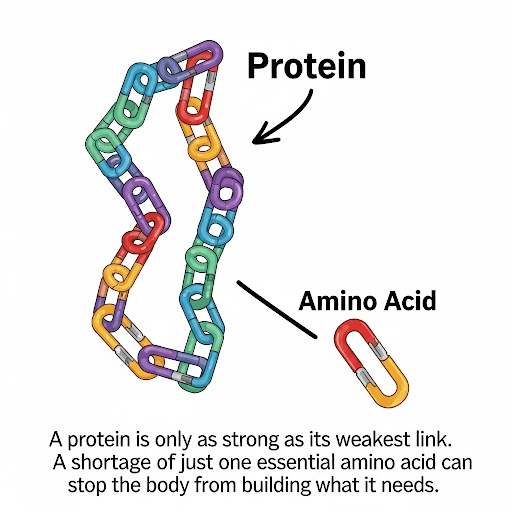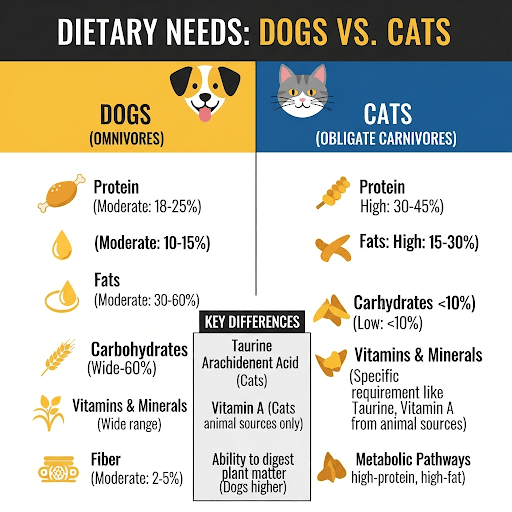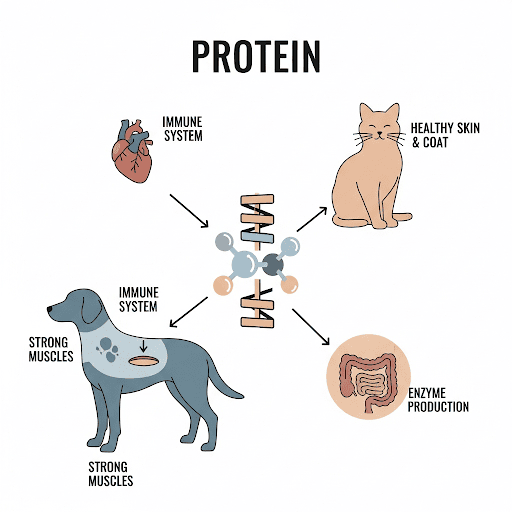In the world of pet nutrition, we've rightfully crowned protein as king. But if protein is the magnificent castle that represents your pet's health, the real story lies in the individual bricks and stones used to construct it. These fundamental materials are the true, unsung heroes of the diet. They are the amino acids.
We often get caught up in the protein percentage on a pet food bag, but the real measure of that protein's value is its amino acid profile. Understanding this next layer of nutrition will fundamentally change how you look at your pet's food. It’s time to meet the real stars of the protein show.
What Are Amino Acids and Why Do They Matter?
So, what are they? Amino acids are organic compounds that chain together to form proteins. Think of it this way: if a specific protein is a long, complex word, then amino acids are the individual letters of the alphabet. To build anything—from muscle tissue and hair follicles to antibodies and enzymes—the body needs the right letters (amino acids) available in the right order to spell the right words (proteins).
Amino acids are divided into two categories:
- Non-Essential Amino Acids: These can be synthesized by your pet’s own body, so they don't need to come from their diet.
- Essential Amino Acids: These must be supplied by the food your pet eats. A deficiency in even a single essential amino acid can bring the body's entire construction process to a grinding halt.
There are 10 essential amino acids for dogs and 11 for cats. This small difference is one of the most important distinctions in all of pet nutrition.
The Critical Amino Acids for Dogs and Cats
While all essential amino acids are, by definition, critical, some have species-specific requirements that every pet owner should know.
For Cats (The Taurine Story): That 11th essential amino acid for cats is Taurine. Unlike dogs, cats cannot synthesize enough taurine on their own and must get it directly from their food—specifically, from animal tissue. A taurine deficiency in a cat is catastrophic, leading to a severe heart condition called dilated cardiomyopathy (DCM) and a form of irreversible blindness called feline central retinal degeneration. This is a non-negotiable dietary requirement. Cats also have a higher need for Arginine, another amino acid crucial for removing ammonia from the body.
For Dogs: While dogs can typically produce their own taurine, recent research has explored a link between certain diets (particularly some grain-free formulas relying heavily on legume proteins) and an increased risk of DCM in specific breeds. Because of this, many high-quality dog foods now supplement with taurine as a proactive measure for heart health.
Ensuring these species-specific needs are met is vital for pet health. Our meal planner app's formulation database is built around the unique amino acid profiles required by dogs versus cats. It automatically ensures that any meal plan for a cat is rich in taurine and arginine from high-quality animal sources, providing peace of mind in every bite.
How Protein Source Determines Amino Acid Quality
This brings us to the most important question: how do we ensure our pets get all the essential amino acids they need? The answer lies in the protein quality in pet food, which is determined by its source.
A "complete protein" is a source that contains all the essential amino acids in the correct proportions.
- Animal-based proteins (from meat, fish, and eggs) are complete proteins. They provide all the essential amino acid "letters" your dog or cat needs and in a form that is highly digestible.
- Plant-based proteins (from corn, soy, peas, and lentils) are often "incomplete," meaning they are naturally low in one or more essential amino acids, such as lysine, methionine, or tryptophan.
While skilled nutritionists can combine various plant proteins or add synthetic amino acids to create a complete profile, the most straightforward and biologically appropriate foundation for dogs and especially for cats is high-quality animal protein.
(The debate over protein sources is important. Learn more in our article [Exploring Different Protein Sources: Chicken, Beef, Fish, and More].)

Conclusion: Looking Beyond the Percentage to the Power of Amino Acids
The true power of protein isn't in its quantity, but in its quality—its complete and balanced profile of amino acids for pets. These essential building blocks are the foundation for everything from a strong heart and sharp vision to a healthy immune system and a gleaming coat.
The next time you evaluate your pet's food, challenge yourself to think beyond the crude protein percentage. Look deeper at the ingredient list and consider the source of that protein. You're no longer just looking at an ingredient; you're looking for the essential, life-giving "letters" that build your pet's health.
Building your pet's health starts with the right bricks. Discuss the importance of protein quality with your veterinarian, and trust our meal planner to build a diet that makes every single amino acid count.


